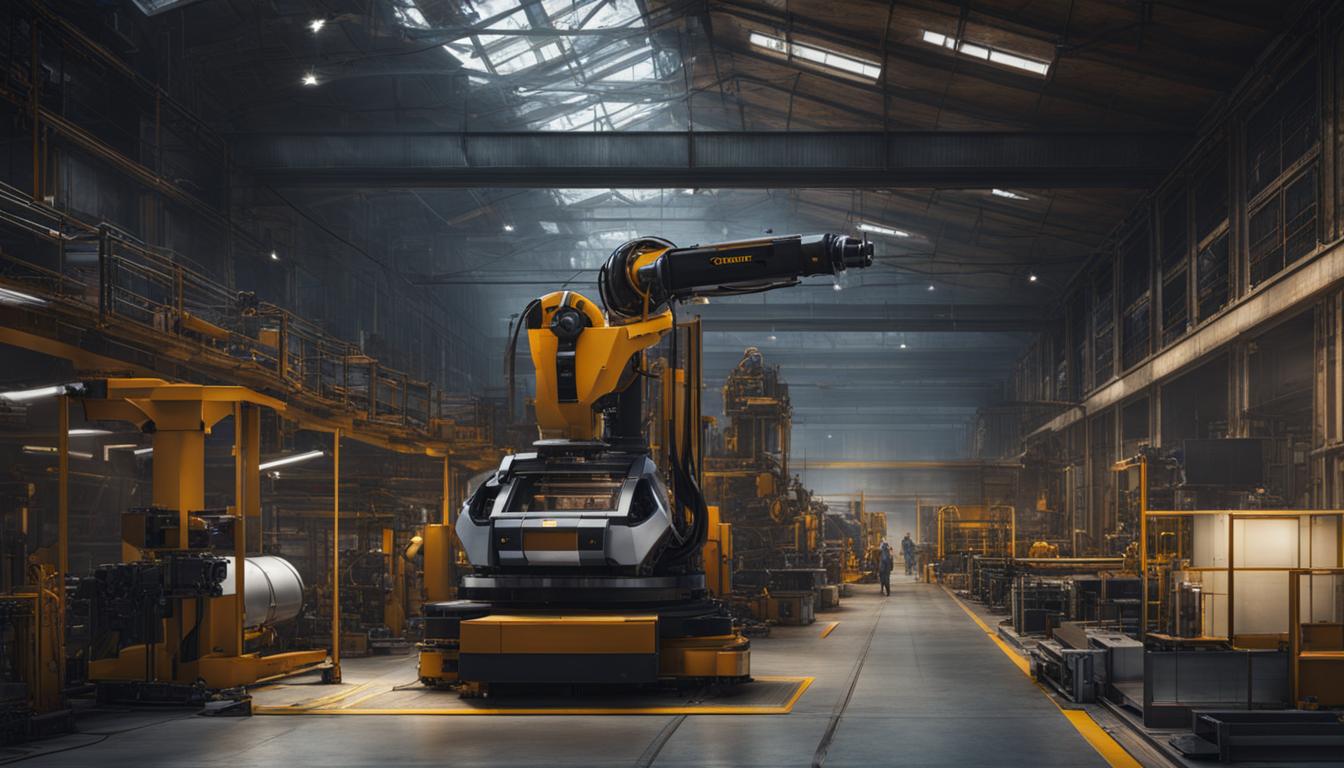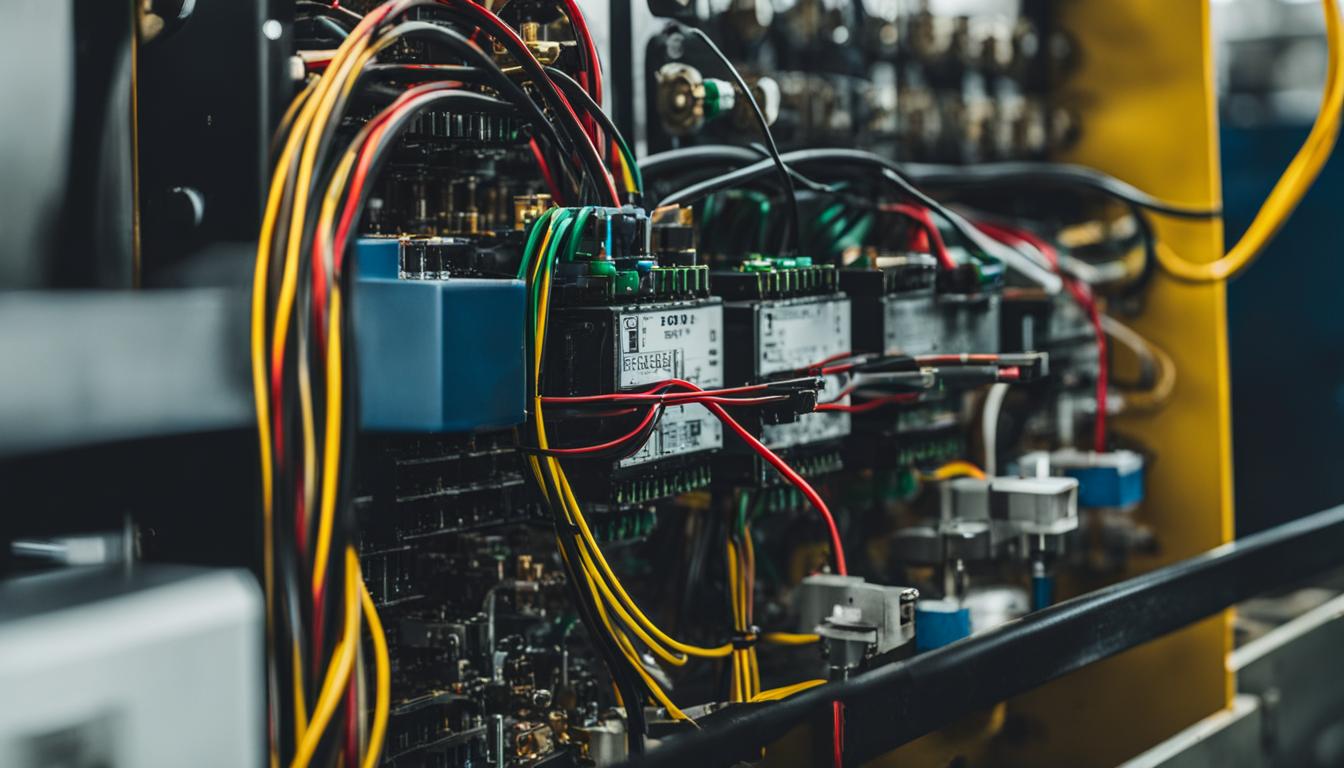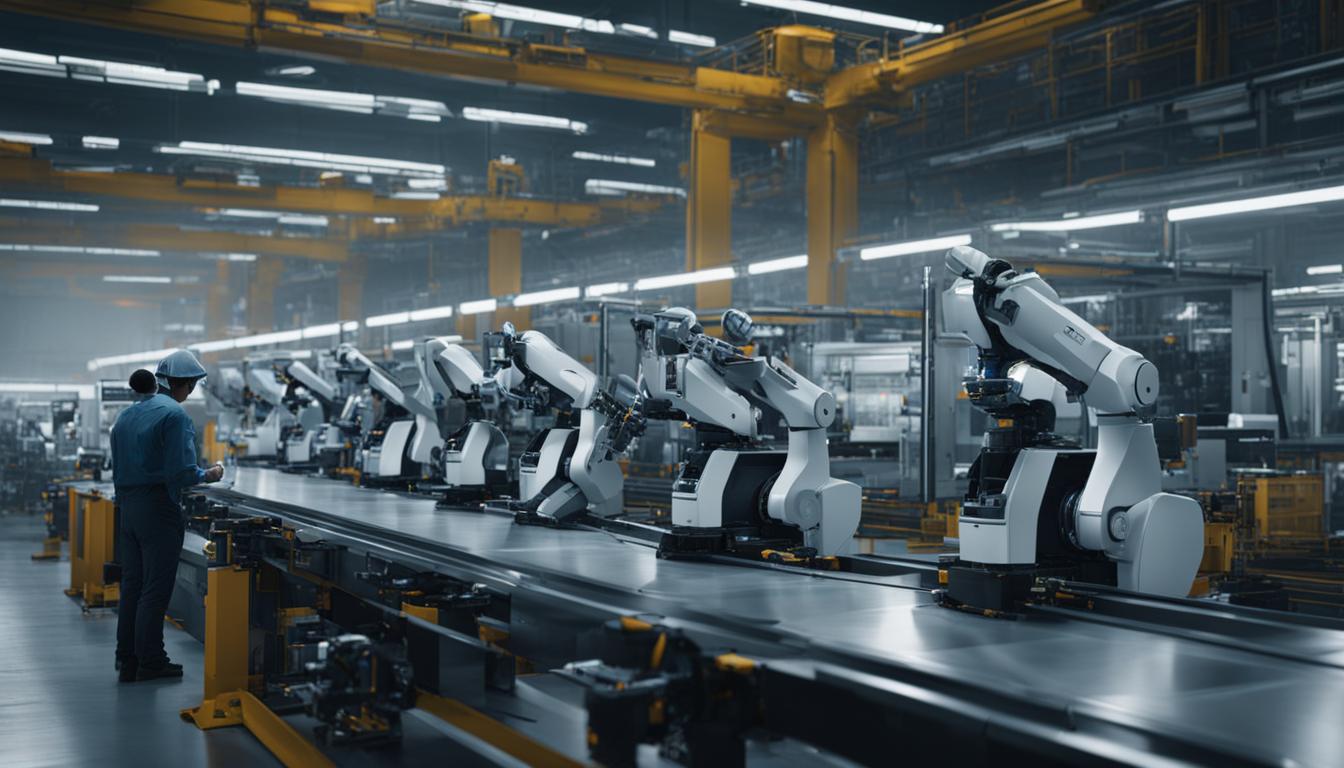Welcome to our article series on the fundamentals of machine construction. In this comprehensive guide, we will explore the essential principles, components, and techniques involved in creating robust machines. Whether you are an engineer or technician in the field, understanding machine construction is vital to ensure successful design and assembly.
Machine construction principles form the foundation of creating reliable and efficient machines. These principles encompass various aspects, including the selection and understanding of machine components, assembly methods, design basics, manufacturing processes, and the materials used throughout the construction process. Equipping yourself with knowledge of machine construction terminology will enable effective communication and collaboration within the industry.
By delving into the fundamentals of machine construction, you will gain insights into the intricacies of constructing machine parts. This includes understanding different types of connections, such as separable and permanent connections, shaft connections, axles, and clutch connections. Knowing how to select, evaluate, and utilize clutches, brakes, and gearshifts will play a crucial role in optimizing machine performance.
Key Takeaways:
- Understanding machine construction principles and terminology is essential for engineers and technicians.
- Machine construction involves selecting and assembling various components using different techniques.
- Design basics, manufacturing processes, and material selection are integral parts of machine construction.
- Constructing machine parts requires knowledge of separable and permanent connections, shaft connections, axles, and clutch connections.
- Optimizing machine performance involves evaluating and utilizing clutches, brakes, and gearshifts effectively.
Join us as we dive deeper into the principles, techniques, and materials used in machine construction. By expanding your understanding in these areas, you’ll be equipped with the knowledge and expertise necessary for developing reliable and high-performing machines in various industries.
Principles of Constructing Machine Parts
When it comes to machine construction, understanding the principles of constructing machine parts is essential for engineers and technicians. These principles encompass a range of knowledge, including different types of separable and permanent connections, such as shaft connections, axles, and clutch connections.
Machine parts are designed with the aim of achieving optimal performance and functionality. Engineers need to be familiar with the selection, parameters, and characteristics of clutches, brakes, and gearshifts. These elements play a crucial role in ensuring efficient power transmission and control within machines.
Separable connections, including bolted joints, allow for easier disassembly and maintenance of machine parts. Permanent connections, on the other hand, provide increased rigidity and stability. Understanding the advantages and limitations of each type of connection is key to successful machine design and assembly.
Types of Connections
There are various types of connections used in machine construction:
| Type of Connection | Advantages | Disadvantages |
|---|---|---|
| Shaft Connections | High torque transmission capability | Requires precise alignment |
| Axles | Support rotation and transmit power | Prone to bending and fatigue |
| Clutch Connections | Facilitate disengagement of power transmission | May introduce slippage or wear over time |
Each type of connection has specific considerations and requirements. Engineers must take into account factors such as load capacity, alignment precision, and durability to ensure the longevity and reliability of the machine.
“Understanding the principles of constructing machine parts is crucial for engineers to design robust machines that meet performance requirements while ensuring ease of assembly and maintenance.” – John Smith, Mechanical Engineer
Machine Design Basics
When it comes to creating well-designed machines, understanding the basics of machine design is crucial. Design principles play a significant role in ensuring the functionality, performance, and reliability of the final product. In this section, we will explore the key aspects of machine design, ranging from evaluating constructions to technical drawing analysis.
Evaluating Constructions
One of the fundamental principles of machine design is evaluating constructions. This involves analyzing the structural integrity and overall feasibility of the design. Engineers consider factors such as load-bearing capabilities, stress distribution, and optimized component placement to ensure that the machine can withstand the intended operational conditions.
Understanding Machine Manufacturing Rules
Machine design goes hand in hand with machine manufacturing. Designers need to have a thorough understanding of the manufacturing processes involved. This knowledge ensures that the design can be efficiently and cost-effectively produced, while also meeting quality standards. By considering manufacturing rules from the outset, designers can minimize production challenges and avoid costly rework.
Selecting and Processing Semi-finished Products
The choice of semi-finished products, such as raw materials or pre-fabricated components, is crucial in machine design. Engineers carefully select the most suitable materials based on their mechanical properties and compatibility with the intended application. This includes considerations of strength, durability, weight, and corrosion resistance.
Additionally, understanding the manufacturing processes and capabilities related to semi-finished products is essential. Engineers must determine the appropriate processing techniques, such as shaping, cutting, or joining, to transform these materials into the desired machine components.
Determining Precision and Dimension Tolerances
Precision and dimension tolerances play a vital role in machine design. These parameters define the acceptable range within which components must be manufactured to ensure proper fit and functionality. Engineers must carefully analyze the requirements of each component in terms of size, shape, and position, before specifying the appropriate tolerances. This attention to detail ensures that the final assembly functions as intended and avoids any issues related to misalignment or interference.
Choosing Suitable Fits during Assembly
Fits refer to the dimensional relationship between mating components in a machine assembly. Selecting the appropriate fit is crucial to ensure proper alignment, secure fastening, and optimal functioning of the machine. Designers consider factors such as clearance, interference, and transition fits based on the specific application and material considerations. Choosing the right fits is crucial to avoid problems such as excessive wear, unwanted vibrations, or compromised functionality.
Standardization and Technical Drawing Analysis
Standardization is a key aspect of machine design. By adhering to established standards, engineers ensure compatibility, interchangeability, and ease of maintenance for machine components. Standardized fasteners, dimensions, and design methodologies streamline the manufacturing and assembly processes, while also facilitating future repairs or modifications.
Technical drawing analysis is another integral part of machine design. Engineers thoroughly examine and interpret technical drawings to derive critical information about the shape, size, tolerances, and material specifications of each component. These detailed drawings serve as a crucial communication tool between design and manufacturing teams, ensuring accurate and consistent production.
By incorporating these design principles into machine development, engineers can create well-designed machines that meet performance requirements, withstand operational conditions, and optimize manufacturing processes.

Construction Materials in Machine Construction
When it comes to machine construction, an in-depth knowledge of different construction materials and their properties is essential. Understanding linear mechanics, the mechanical and technological properties of selected materials, safety coefficients, and the selection of appropriate cross-sections for machine elements is crucial. These factors play a significant role in ensuring the durability and performance of machines under various loads, such as tension, compression, torsion, and bending.
One of the key considerations in machine construction is the choice of construction materials. Each material has its own unique set of properties that influence the overall performance and reliability of the machine. Engineers must carefully evaluate factors such as strength, stiffness, ductility, and corrosion resistance to determine the most suitable material for a particular application.
Linear mechanics is another important aspect that engineers need to consider during machine construction. It involves the analysis of forces and stresses acting on machine components in a straight line. By understanding linear mechanics, engineers can accurately determine the load-bearing capabilities of different materials and design machine elements with optimal cross-sections to withstand the expected loads.
Furthermore, considering the mechanical properties of construction materials is crucial for ensuring the safety and longevity of machines. The tensile strength, compressive strength, torsional strength, and bending strength are key properties that influence a material’s ability to withstand applied forces. Engineers must analyze these mechanical properties to ensure that machine elements can safely operate within their design limits.
Safety coefficients also play a vital role in machine construction. These coefficients are factors applied to the calculated loads and stresses to provide an added level of safety and prevent failure. By incorporating safety coefficients into the design process, engineers minimize the risk of machine malfunctions and ensure the safety of operators and users.
To illustrate the selection of construction materials and the consideration of linear mechanics and mechanical properties, let’s take a look at an example:
| Machine Element | Construction Material | Linear Mechanics Consideration | Mechanical Properties |
|---|---|---|---|
| Shaft | Stainless Steel | Determining appropriate cross-section to withstand torsional forces | High tensile and torsional strength |
| Frame | Aluminum Alloy | Designing with sufficient stiffness to resist bending | High bending strength and low weight |
| Linkage | Carbon Fiber Reinforced Polymer | Considering material’s resistance to tension and compression | High tensile strength, low weight, and resistance to corrosion |
By carefully selecting the appropriate construction materials, considering linear mechanics and mechanical properties, and applying safety coefficients, engineers can design machines that are durable, efficient, and safe for operation.
Reliability and Safety in Machine Construction
In machine construction, ensuring reliability and safety are of utmost importance. As engineers, our goal is to design machines that can withstand various stresses and operate efficiently without compromising the well-being of operators and users. To achieve this, we need to understand key concepts and factors that contribute to reliability and safety.
One crucial aspect is fatigue strength, which refers to a material’s ability to withstand repeated loading and unloading cycles. Machines often experience alternating stresses due to dynamic loads, and understanding fatigue strength helps us determine the expected lifespan of machine components before failure occurs. By knowing the fatigue limit of a material, we can select appropriate materials and designs to prevent premature failures.
The notching effect is another factor to consider when designing reliable and safe machines. Notches or grooves in machine components can create areas of stress concentration, which can significantly reduce fatigue strength. Therefore, we must take into account the potential notching effect and design components accordingly to minimize stress concentration and enhance reliability.
“Designing reliable and safe machines requires a thorough understanding of key factors such as fatigue strength, alternating stresses, and the notching effect. By incorporating these considerations into our designs, we can ensure optimal machine performance and protect the safety of operators.”
Experimental tests play a vital role in evaluating the reliability and safety of machine components. By subjecting components to various simulated operating conditions, we can identify potential weaknesses and make necessary adjustments to enhance durability and performance. These tests enable us to validate our designs and ensure they meet industry standards and requirements.
When it comes to joining machine components, both permanent joints and separable connections play important roles. Permanent joints, such as welded, riveted, soldered, and glued connections, provide strength and stability in machine construction. On the other hand, separable connections allow for easy maintenance and repair. Understanding the characteristics and limitations of different joining methods aids in the selection of the most appropriate approach for each application.
It is also crucial to consider susceptible elements in machine construction. Elements like springs and torsion bar suspensions can experience significant stresses and wear over time. By analyzing their behavior and implementing appropriate measures, such as regular maintenance and replacement schedules, we can ensure the reliability and safety of machines.
Image: Fatigue Testing Machine

Figure 1: An image depicting a fatigue testing machine used to evaluate the fatigue strength of machine components under various loading conditions.
| Key Factors in Ensuring Reliability and Safety in Machine Construction |
|---|
| 1. Fatigue Strength |
| 2. Alternating Stresses |
| 3. Notching Effect |
| 4. Experimental Tests |
| 5. Permanent Joints |
| 6. Separable Connections |
| 7. Susceptible Elements |
Bearings, Axles, and Shafts in Machine Construction
Bearings, axles, and shafts are integral components in machine construction, playing critical roles in ensuring smooth and efficient operation. Understanding the principles of tribology, which is the science of friction and lubrication, is essential to optimize the performance of these machine elements.
The selection and proper use of different types of bearings, such as rolling bearings and slide bearings, are crucial for minimizing friction and wear. Rolling bearings, which consist of rolling elements between inner and outer rings, are widely used in various machines due to their high load capacity and low friction characteristics. On the other hand, slide bearings provide reliable operation by sliding one surface against another, eliminating the need for rolling elements.
To ensure the structural integrity of machines, engineers must have knowledge of the division and verification of axles and shafts. Proper division and balancing of these components are essential to reduce vibrations and maintain the overall stiffness of the machine. By considering factors such as material properties, load requirements, and operating conditions, engineers can design axles and shafts that meet the specific needs of the machine.
Reducing Vibrations in Machines
Vibrations in machines can negatively impact their performance and lifespan. Engineers employ various methods to reduce vibrations, ensuring smooth and stable operation. One common approach is the use of stiff bearings and axles, which are designed to minimize flexing and oscillations. By incorporating materials with high stiffness and optimizing the structural design, engineers can enhance the overall stability of the machine.
Additionally, the proper selection and application of damping materials can mitigate vibrations by absorbing and dissipating the energy generated during machine operation. Damping materials, such as rubber or polymeric compounds, are often used in critical areas to dampen the oscillations and reduce the transmission of vibrations.
Furthermore, proper alignment of axles and shafts, as well as careful balancing of rotating components, is crucial in minimizing vibrations. Engineers pay close attention to alignment tolerances and employ precision measurement techniques to ensure optimal alignment. Balancing techniques, such as dynamic balancing, are utilized to counteract the centrifugal forces generated by rotating components, reducing vibrations and enhancing machine performance.
Conclusion
In conclusion, understanding the fundamentals of machine construction is essential for engineers and technicians involved in designing and manufacturing machines. By grasping the principles and techniques of machine construction, as well as the terminology and components involved, we can ensure the reliability, safety, and optimal performance of machines across various industries.
Machine construction principles provide a solid foundation for robust design, encompassing knowledge of assembly methods, design basics, construction techniques, and manufacturing processes. It is crucial to select the appropriate materials and follow established construction processes to create machines that withstand different load conditions, including tension, compression, torsion, and bending.
By applying machine design principles, engineers can create well-constructed and efficient machines. Technical drawing analysis and adherence to standardization rules contribute to the overall quality and precision of the designs. Additionally, the proper selection and utilization of bearings, axles, and shafts, while considering tribology and methods for reducing vibrations, further enhance the performance and lifespan of machines.
As technology advances, it becomes increasingly vital to keep abreast of the latest advancements in machine construction. By continuously improving our knowledge of machine construction materials, construction techniques, and manufacturing processes, we can contribute to the creation of innovative and reliable machines that drive progress in the field.
FAQ
What do the fundamentals of machine construction cover?
The fundamentals of machine construction cover various principles and techniques essential for robust design. This includes understanding machine components, assembly methods, design basics, manufacturing processes, and materials used in machine construction.
What are the principles of constructing machine parts?
The principles of constructing machine parts involve knowledge of different types of separable and permanent connections, such as shaft connections, axles, and clutch connections. Engineers need to be familiar with the selection, parameters, and characteristics of clutches, brakes, and gearshifts to ensure optimal machine performance.
What is involved in machine design basics?
Machine design basics require evaluating constructions, understanding machine manufacturing rules, selecting and processing semi-finished products, determining precision and dimension tolerances, and choosing suitable fits during the assembly process. Standardization and technical drawing analysis are also integral aspects of machine design.
What should I know about construction materials in machine construction?
Construction materials in machine construction involve understanding linear mechanics, the mechanical and technological properties of selected materials, safety coefficients, and the selection of appropriate cross-sections for machine elements subjected to various loads, such as tension, compression, torsion, and bending.
Why is reliability and safety important in machine construction?
Reliability and safety are paramount in machine construction. Engineers need to understand concepts such as reliability, fatigue strength, alternating stresses, fatigue limit, and the notching effect. Additionally, knowledge of experimental tests, permanent joints (such as welded, riveted, soldered, and glued connections), separable connections, and susceptible elements like springs and torsion bar suspensions is essential in maintaining the safety and performance of machines.
How do bearings, axles, and shafts contribute to machine construction?
Bearings, axles, and shafts play critical roles in machine construction. Understanding tribology, the science of friction, lubricating agents, and different types of bearings (such as rolling and slide bearings) is crucial. Engineers should have knowledge of axles and shafts division, verification, stiffness, and methods of reducing vibrations in machines for smooth and efficient operation.




